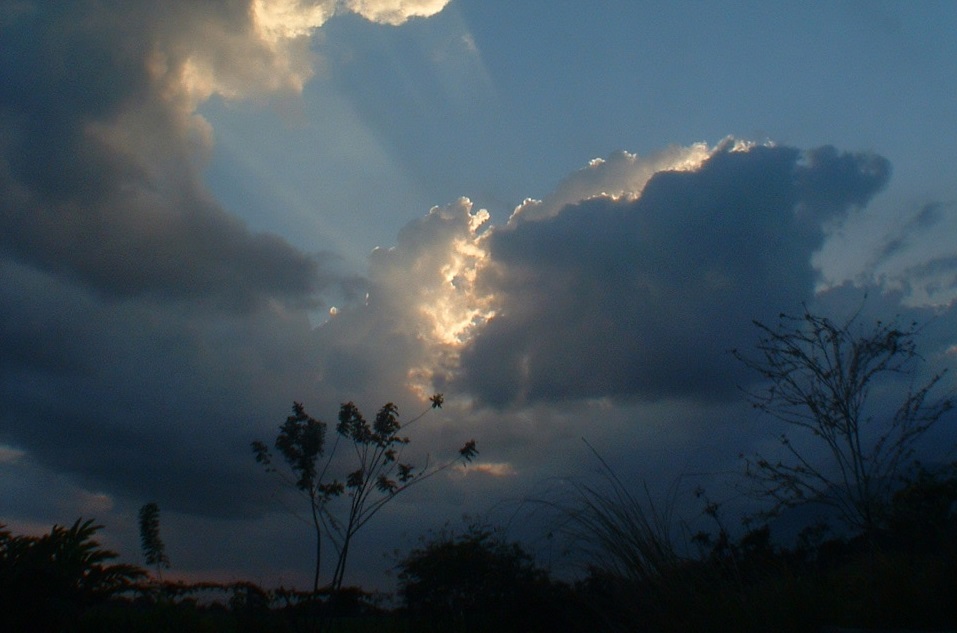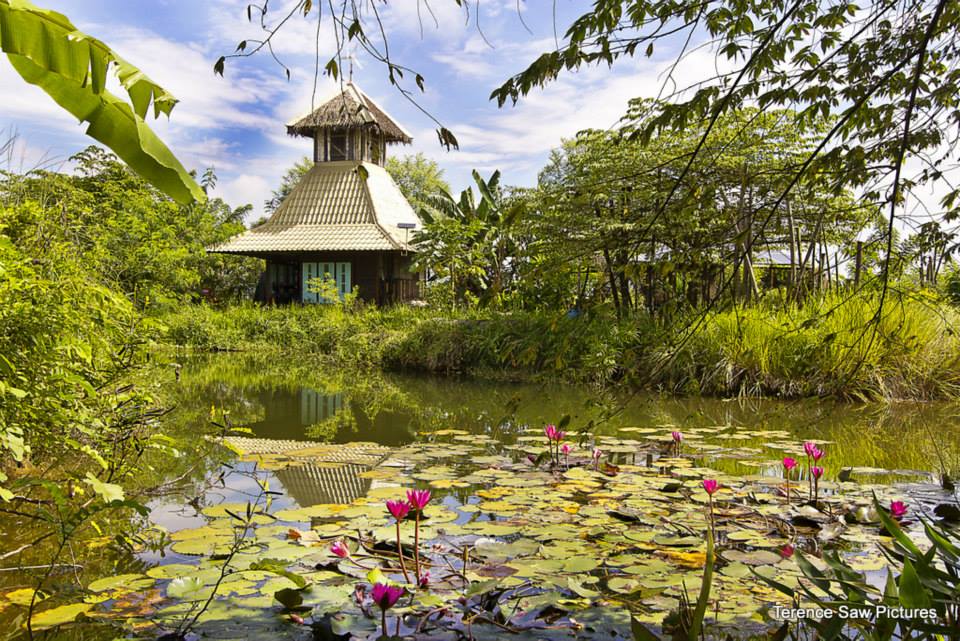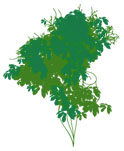ここでは私の友人、ジョン・バーミューレンが運営するパーマカルチャー農園をご紹介します。
彼の農園は、フィリピンのバダンガス、リパに位置する諸島 – ルゾン島にあります。美しい大自然の中で、自然の摂理と共にコーヒー農園とエデュケーションセンターを運営しています。もしあなたが関心を抱いてくださるなら、ぜひ彼らのファームを訪ねてください。
|
PROFILE
|

|
John Vermeulen was born in South Africa from Dutch decent and lived in both South Africa and The Netherlands for an extensive time. At Cape Town, South Africa, he completed his Master studies as an Industrial Designer -Three Dimensional and at the Design Indaba of 2006, he won the prize for the Most Innovative Design with a tricycle model for a sustainable rural transport project affiliated with SABS. He completed his Ecovillage Design and Permaculture Training at Finhorn Scotland and Wongsanit, Thailand in 2007. Having been based in the Philippines since 2008, he designed, constructed and completed an Eco-Homestead, Green Bed & Breakfast Inn & Education Center project at Cabiao, Nueva Ecija, named “Tuwâ The Laughing Fish”. John promotes a low-carbon lifestyle and is an active, appropriate technologist, designer and permaculturist. He currently lives at the foot of Mount Malarayat – a beautiful coffee mountain at Lipa, Batangas, Philippines.
|
|
ジョン・バーミューレン
南アフリカでオランダ系の両親のもとに生まれ、アフリカとオランダに育つ。
南アフリカのケープタウンにてインダストリアルデザイナーの修士号を取得後、スコットランドのFindhornとタイの Wongsanitにてエコビレッジ・デザインとパーマカルチャーについてのトレーニングを受講。 フィリピンをベースにグリーンなベッド&ブレックファスト、コーヒー農園、エデュケーションセンター『Tuwâ The Laughing Fish』を2008~2014年まで運営(現在、別オーナーが運営中)。現在はルゾン島に位置するバタンガスのリパに在住。発展・開発がすすむ中、保護を必要とする山の麓にて、大自然に囲まれ奥さんと共に暮らす。
|

Photo Credit: TAO Philippines
Palawan, the island on the south west part of the Philippines known as “the last frontier” was the stage of inspiration for two backpackers, Jack and Eddie, who started island-hopping in this region in 2006. They were so mesmerized by the raw beauty and remoteness of this area that they started planning sailing trips for other likeminded travelers.
Eventually, their passion for nature and adventurous island spirit gave birth to TAO Philippines – a boat expedition that allows tourists to visit more than 200 remote islands along a 150 kilometer route between El Nido and Coron, Northern Palawan. The growth of their island venture has been phenomenal and after nine years, the concept has expanded beyond their wildest dreams.
TAO, which translates into “people” in the native Tagalog language, embodies the central focus of their business. Here, tourists become visitors to a Filipino family home and they integrate into the daily local activities in the areas they visit.
Jack and Eddie developed a program that equally shares the benefits brought by their eco and people-centered tourism activities to the whole community. In 2007, they set up the TAO Kalahi Foundation to help, educate and sustain the local islanders and their communities. Since then, many daycare centers for pre-school children, and womens’ livelihood groups were established.

The beautiful training center on “the farm” built in 2014
from bamboo and native materials.
Photo Credit: Jack Foottit
But as with every rapidly growing success, they are having to adopt to the changing challenges of the times. So, about two years ago, TAO Philippines approached us while we were settling in at our new coffee farm located in Lipa, Batangas and asked us to determine if we could help them with growing concerns.
We explained what we were doing with permaculture and the social tools like transition initiatives and how this could be adopted to tailor-fit their local community.
And before we knew it, a month later, the exciting first journey started-off in Coron after a short flight from Manila. The devastating typhoon Yolanda –internationally known as Haiyan – had just passed and there was still a clear scar through the landscape and the human settlements as we traveled by boat along the coastline. Due to TAO’s close relationship to the community and their fleet of touring boats, they were one of the first groups out after the storm, assessing the vast damaged area and the crying need for water, food and shelter as they were connecting with the people. All the blue tarpaulin roofs along the shoreline –literally hundreds- were a sign of the quick aid they were able to disseminate as they coordinated very effectively where things had to be brought and a transportation network insured safe and fair distribution of medical aid and other goods.

Some of the devastation that Yolanda left behind.
Photo Credit: TAO Philippines
After spending hours on the open calm seas, we arrived at one of the basecamps where we learnt about the loss of boats and the idea emerged of starting to build fiberglass boats for the fishermen as they are more durable and less wood was required for the project of replacing some of the lost “bancas” –small boats.
While doing some interviewing to explore different traditional ways of boatbuilding and waterproofing their vessels, an amazing natural solution seemed to emerge. There is a native tree that grows abundantly on the islands and the sap or resin is collected from these “sahing” trees. It is used as a glue to bond the wood in the boat construction; it can be used as a waterproofer but can also be utilized as a fire starter due to the oils in the sticky white sap. Later we found out that it has great healing power and it is converted into a very expensive tincture but can also be an effective lacquer.

An amazing vessel called a Paraw- native double out rigger sailboat- was built by
TAO to educate youngsters about their heritage.
Photo Credit: TAO Philippines
Our journey lead us past amazing mangroves, found thermal springs in lagoons and experienced breathtaking sunsets while drinking the refreshing water from a coconut and eating freshly caught fish that had just been grilled on an open fire.
The traditional drink that they serve on the expeditions is rum and pineapple juice from a can. Observing the local communities and their cooking habits brought the rocket stove into the picture, sharing the benefits of a cleaner burn and more energy efficiency. Hence the conversion of the “waste” pineapple cans into the base material of the stove with the help of aviation snipes, we taught the TAO “lost boys” how to help everybody ingenerating a new awareness of what resources are.

On our return a year later the project had grown into an effective result, bigger and more experimental models were around of the rocket stove burning coconut shells and offcuts of bamboo in the smokeless and energy focused stoves.
Photo Credit: TAO Philippines
One of the most memorable experiences would be a massage on the beach of the base camp called “the farm,” in the open air with the revitalizing fresh breeze from the sea and a smell of tantalizing home made coconut oil. The TAO Foundation set up a program to empower the local women in fishing communities addressing several concerns all at once.
Due to the dwindling fish population more men are forced to stay home resulting to boredom, drinking and more pregnant women. So the incentive of TAO through their foundation started to educate the local women to make coconut oil for massages and gave them an excellent training, thus making them less dependent on resources. Due to the tours they would have a steady income as almost every other night a boat will visit the island during the warm dry season.
To insure social monitoring, the massages are given on the beach, avoiding mistrust from their husbands. Also, the TAO Foundation requires the masseuse to not be pregnant while they are working. By introducing this program they encapsulated many concerns and have used a clever way of protecting the women as they now have rights in the households due to income they are bringing home and giving them a voice and more importantly, empowering them to take control of their reproductive health.
Because “the farms’” location is not too remote, supplies can be sourced easily from the local village, which are then delivered by boat or motorcycle and then passed on again to the fleet. The beach has become an active scene for refilling the boats with drinking water, replenishing food stocks as the boats pass, but cement or iron wares like deep well pumps or nails, plumbing stocks and lumber also leave from here often too. Diesel fuel can also be bunkered here but future visions can change many old approaches with new attitudes inspired by old lost customs.

The Paraw in the bay of “the farm” close to El Nido
Photo Credit: Scott Sporleder
If we were to look closer at the air picture that was taken by a drone, we see a vast coastline filled with coconuts. This is the first classic image that we would see or have of a tropical island, but the real life of this sandy beach has another story to tell and it dates back to not too long ago, an astonishing truth that will make your jaw drop!
Up until fifty years ago, there was a dense tropical forest on that exact location, with lush vegetation and wildlife that could make a zoo owner lick his lips for; reptiles, fish, birds and insects. All had been taken for manly profit and then replanted with coconut to produce controlled healthy environments “we” could flourish from.
During our first visit to “the farm” we were invited to assess the productivity of the vegetable gardens, which were already been fertilized with bokashi. The biggest flaw we were able to address was the bare soil being exposed in the challenging tropical sun, drying out the soil and sterilizing the microbial life in it. By adding layers of mulch, a microclimate is developed where moisture retention is increased and this makes place for diverse bacterial and fungal growth aiding in the energy exchange of living matter leading into higher yields and long-term investment into the soil.

A proud group of TAO staff sharing their abundant produce after improving the soil condition of their gardens
Photo Credit: TAO Philippines
So, a year later we were again invited by TAO to help resolve a much bigger challenge, a water crisis or shortage. As permaculturists, we looked at the phenomena from many angles and the predominant point that came to mind was El Nino with it’s warmer period that has been occurring more frequently in the last few decades around the Pacific area. The impact of this pattern results into warmer and drier periods than normal recurring weather systems.
At the TAO farm, the springs along the higher mountain slopes that would feed into the storage tanks were starting to flow weakly, sparsely replenishing their water reservoirs. As an emergency resolve, we gave several recommendations and TAO founders readily welcomed and implemented them.The water flushed toilets were now rinsed with seawater, but knowing that it could destabilize the bacterial decomposition due to the preserving character, a separate septic tank was built to store the salty wastewater. This action also prevented the black water from seeping into the ground preventing that the soil will turn brackish and have detrimental effect on the vegetation in the long run.
Drinking water was to be rationed and bathing options were reduced to a few scoops of fresh water after washing in the sea. The garden production came almost to a halt, only the seedlings that had already been sprouted were all brought together to a few growing-beds so that they could survive and intensive shading was created to prevent burning in the hard sun.
A water dowser was brought in to see if there were any other fresh water sources on “the farm” and after searching about for hours there were three new locations that showed potential. Interesting enough, they all seemed to be on the edge of the property where the flatter land met with edge of the mountain.
But to make a long-term impact on the water stability we would have to change the landscape, remediate it as a lot of the original vegetation had been lost either by logging, burning or decay as s result of an unstable fertilization system that naturally is kept in place by a healthy forest.
The first step is to identify the best places on the slope of the mountain to then build in swales using them to then stop or slow down the water, then spread it along the slope on contour of the mountain and then soak it into the ground during the rains.

Digging the swale lines in the dry soil to improve soakage
Photo Credit: Penelope Reyes
Besides cutting swale lines into the soil we chose biomass to build swale lines where there were too many rock formations. Coconut palm leaves were stacked in creative manners or banana plants were pruned to improve the yields and the massive trunks were halved and laid out in a planned fashion to then too create dense swale lines.
In all the research we did in the area of Palawan we were baffled by such startling facts as elders recalling areas that were almost like marsh lands filled with huge trees and water which made way for rice fields that have been around for only fifty years but have turned the land into barren areas of dust.
And slowly the lush green mountains are becoming a quilt of scarred land, exposing the soil to the rains that easily wash away all the nutrients as the forests have been slashed and burned.

Viewing a landscape, victim to slash and burn practices, a painfully sad sight
Photo Credit: Jack Foottit
But how is this possible? Apparently the local government issues a permit to people who want to convert this “useless” dense forest land into productive agricultural areas. With this approach, the wood that is cut is sold at a low cost to cover some of the farmers cost, after which the burning supplies some potassium to the land and helps with the first harvest of rice that is then planted and followed by a crop of cassava. If one does the math it seems ludicrous as to what is gained form all these actions; a few sacks of rice?
The most amazing thing is that if a new and more simple approach would be taught there would be even greater potential as we have tried on our farm in Lipa, Batangas. Here we used a permaculture principle called food forest systems to convert commercial farmland into multi-crop abundance.

Our lush permaculture garden filled with food all around.
Photo Credit: Kevin Velasco
It is easy to imagine the Philippines with tremendous potential as the tropics can yield so much with root crops like turmeric, gingers and sweet potatoes growing underground, pineapples, purslane and morning glory as ground cover, shrubs of citrus or coffee as understory with bananas over it all with coconuts towering high above as bees help in the pollination around us; just a simple example!
And with this all, a new micro-climate has evolved into moist areas that can later insure springs drawing in even more moisture and grow into stable springs flowing with pure life.
Underutilized land seems to be the biggest sin I believe in modern times where so much knowledge and proof has been around to conduct a spreading of goals with gigantic positive outcome, enough for everyone, a fair share.
So the big question is, are we willing to make a change before it is all too late?
Or will we be reminiscing natures’ bountiful abundance? If we don’t act now to restore the Earth, maybe the only thing we can do in the future is stare at its images on pods and pads but never to be able to feel the fresh rains on a face or wind blowing the heat away!

It is just one of those nights that everything that you touch has a connection to something else in your life!
To entertain myself, I found a documentary about George Gershwin. He wrote the song Summertime that overtook the world up until today. The tune was mesmerizing; it was so familiar and so close to my heart, it all made some sense. It had been written in the 1930’s, Gershwin, being a Russian Jewish immigrant with an opera in mind, saw the struggle of a black nation in the land of freedom- with unspoken limited possibilities- the America we have grown to know as life changing. And so it is true, times are changing and so do the ideals of people, but they can leave amazing marks.
While the documentary unfolded, the name of Angelique Kidjo passed by and she gave her version of the Summertime lullaby. I searched Kidjo’s rendition on ‘Spotify’ and after listening to it for a few moments, I realized that she had shared space with me once before.
It had been in Cape Town, South Africa and it was the concert that was inspired by Nelson Mandela’s goal to raise awareness on AIDS called 46664. It was there that Kidjo had sung together with so many other icons of my life, Annie Lennox, Jimmy Cliff, Johnny Clegg, Peter Gabriel and Bono.
While my friends and I were standing on the field and journeying in soundscapes, the helicopter of Nelson Mandela flew over in the afternoon. Everybody could feel he was about to arrive, and when he finally entered the Sea Point Stadium Arena, there was a sense of unity, thrill and an ecstatic energy embracing everybody.
As the father of freedom silently holding his hands stood on stage, the crowd was in bliss, cheers and noise filled the air with positive vibrations. It took about ten minutes before he started to share his message with us, and we were thrilled to listen to his clear and powerful vision.
But how was this all relating to me?
Well, a few years before in America, my visit to the Alcatraz prison in San Francisco Bay gave me an insight into the people that had been held there and under which conditions they had to conduct their lives to due their crime ridden mannerisms. And then a week later, I found myself at the Robben Island penitentiary in the bay of Cape Town. It was like Alcatraz in many ways because it revealed the stories of revolutionaries fighting the Apartheid like the ANC movement.
As I entered cell 46664, I could feel the energy imprint of Nelson Mandela surround me. At that moment, the question of insight entered my curiosity; “What did this amazing man understand about life in here?” And then the answer whispered back to me: “ You are totally free in your mind!”
It is hard to explain what and how all these pieces of the puzzle add up to, as we are all looking for the meaning and goals of life, but we can choose from so many directions!

The intriguing optical illusion that kept me occupied for hours.
Well, permaculture is a way to express how the world could work in a more harmonious way, so many things are warped to fit the hand of others with hidden agendas; the finer details will never be openly discussed.
But what is possible in our minds is to see that the power to change the world is in our hands. If there is some discontent with the system, become aware of it but understand that revolting against it will cause a great amount of loss to fight it. It is much better to unite forces and start a movement of people who are like- minded and start a revolution of constructive action, plant seeds of food. The more life is created in our world to absorb the ‘fear machine’, the greater positive diversions can be created.
The power of seeds are amazing, the existing system does not know how to deal with this potential! Together with a friend, we planted sunflower seeds in Amsterdam. Every evening, we would walk the streets and plant the seeds anywhere that there was bare soil. Often we would get stares from strangers or snarls. We even got followed by the police when we covered the grounds around the American Embassy!
So, the thrill is in your own intentions to want to make a difference, take action and make a critical building progress to life!
‘Power to the people’, if only you know it, the thought of positive direction can make that difference.
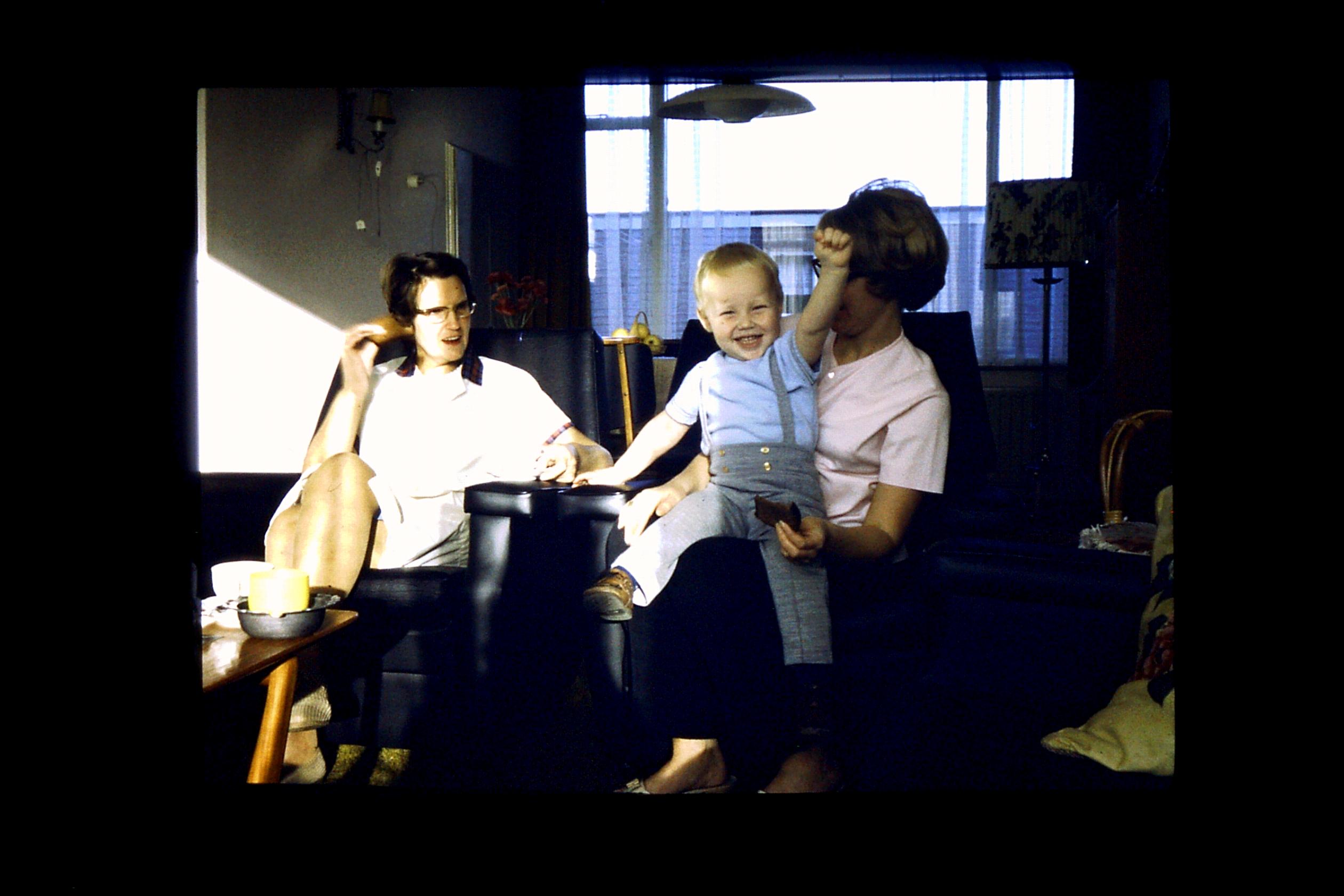
Three generations, my grandmother on the left and me sitting on my mom’s lap,
“power to the people and chocolate cake!”
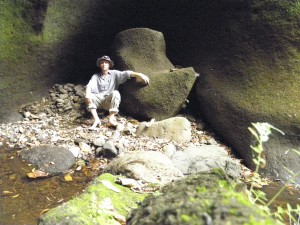
Today was one of those real Sundays, a time to just wander around and let all worries go, it is even the start of a new moon cycle. Being curious about several things such as water levels of the river as the commencing of the dry period had begun and with the quest of freshwater shrimp hunting in mind, the journey into nature started.
With a camera flung over my shoulder and a machete in the right hand, the adventure to the river began, cutting away the lush tropical growth down a steep drop of twenty meters over about 300 meters. Our farm is on the boundary of a village and a river is the marker. Having to pass-by on a neighbor’s lot makes everything easier, no fences are marked with barbed wire, only vegetation of the best kind, Murado – a plant with burgundy-tinted leaves and fast-growing properties – will grow in the soil from a bare well matured cutting and it supplies a sap so sticky, yet medicinal. This is the magical abundant tropics!
The tranquil water chops away at the rock formations as the stony riverbed lays before me in a valley, surrounded by all types of root rope vegetation and birds flitting by. A hornbill inquires about my presence with a new and unfamiliar movement as it perches itself further in the top branches, what a great sight to see!
Dead leaves rustle into the silence of nature. It is stunning to know that people live not further than half a kilometer away! Peace is hovering about, as the believers in Madagascar say: “when a leaf drops on you it will bring you luck, so carry it with joy around for that day; LUCKY LEAF!!”
With the camera, it is hard to capture the scale of things, the milling waterholes almost perfectly round, now serving as bowls as the fallen leaves form a bouquet arrangement of fall colours.

Slabs of rock fit into the puzzles of time as one can slide them back into the gaps where they have been cradled for so many centuries, but now, they expose wedged roots that nestle between them. With the help of water, these roots mustered the force to see daylight. Fierce winds toppled over the masters of time as trees lie across the ridge, making a balanced walk of courage needed to cross the gap. Strange to think that only a year ago, they stood up firm and straight!
When walking through the bolder chaos, bare feet are the choice modus operandi. Get grounded and feel the moisture, relish the coolness of the spring as the city temperature is in the mid-thirty degrees Celsius and this period is predicted to be hot and dry!
So many people have passed by this water channel, kids that grew up to be the folktales of today, old and grey, they are smiling of adventure and show the cave of rituals, it is amazing!
The scale of things still get to me, if one thinks of ancestral life, and how, even my parents are becoming more of a concern for care, we miss each other and want to share more time before all those great times become a shared memory as opposed to a conversation of taste, excitement and collective time.
Why do these thoughts count so much now? Well, Penelope and myself are once more letting go of a special place and want to be amongst family, relatives and like-minded people who share freely, and we also support growing actions towards a community life.
Portugal is currently playing a big role in the awareness of how the ecological component plays a vast role in that society. Permaculture is widely advocated and is explored as a tool to aid nature in creating micro-climates and revitalizing the soil in favour of people, plant and animal needs. Tropical blood runs in both our veins and our goal is to settle down there as the climate is somewhat warmer than the northern part of Europe.
But leaving a country such as the Philippines with its amazing vegetation can create an envious feeling, so much is possible in growth here. From coconuts to edible ferns, sweet papaya or mango, and the list just goes on; what are we willing to leave behind?
A house we built to withstand typhoon forces was really tested by a storm called Glenda- also known internationally as Rammasun- and we did not even ask for that! But the location in the valley of the property insured us that the forces of the wind would blow more over us rather than against us. The roof is arch- shaped, so the strength is great in comparison to a straight-beamed side. Wow, did we catch a fright when a full-grown twenty-meter tall coconut palm fell over our roof right above our heads, while in bed listening through the storm. And fortunately enough, the sturdiness of the roof distributed the impact. It saved our lives!
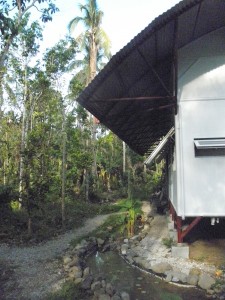
So yes, our farm Ginhawa –wellbeing- is up for sale and we are making good memories as we are working towards an ever-brightening future. Happy Earthday to everyone this month.
And with all these thoughts, captured memories and amazing prospects of the future, the camera slides back into its pouch left there a hour earlier on the river bank, and a leaf greets me inside: lucky you!

Visit Ginhawa
Our daily rhythms come to a close when we settle in our hanging chairs on the far west side of our house and we take time to watch the sunset. Mount Arayat is to the south west and is a massive sundial for a few weeks of the year, on the winter solstice the sun sets on the far left of the mountains foot, just amongst the trees.
Tonight we had an early dinner, Penelope had everything prepared and our whole day’s schedule was slightly off set due to an early visit of curious visitors who were eager to learn more about organic farming and permaculture.
So after a lovely Thai curry and cucumber salad, we went outside again to observe the array of colours we both love these breathtaking, soothing and romantic sunsets.
Seeing that we do this almost every day, there is a pattern that is starting to emerge. The clouds are filling the horizon with sculptures of horses, tortoises or celebrities like Abraham Lincoln before they transform into rimmed outlines that create the backdrop for nocturnal birds like the owls.
This evening, we were blessed with an amazing spiral glide, as the two owls who reside here were swerving closer in each loop that they flew, drawing closer and closer — we could almost touch them, and then, on the last second, they both drew to different corners of our rice fields.
Slowly the grey sky was transformed by blotted lines that make no sense as the bats fall like a squadron of fighter pilots from the roof of my workshop: Likha- this means to “create” in the Tagalog Pilipino language.
And so the day folds into the veil of night and serene darkness, our hearts are filled with joy and excitement as our wild family took the time to dance with us.
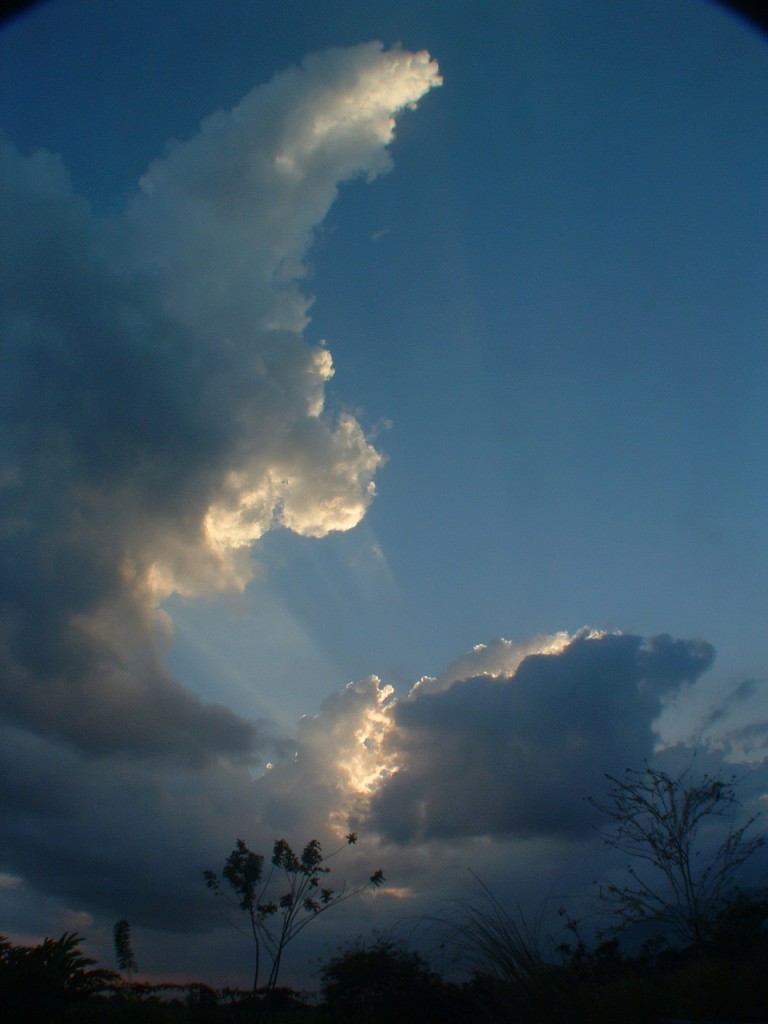
We had a visit from Philip Matzigkeit, a mural artist and interior designer from San Diego who spent a few days here at our home, Tuwa The Laughing Fish.
We hit it off very well because, one, both our roots anchored in Africa, he had lived in Zimbabwe -or at that time Rhodesia- and I was his next-door neighbor, being from South Africa. Sharing patterns of artists like the Ndebele, Malcolm X and freedom, brought forth memories alike of what great lives of riches we have spent.
In all my travels around the world I found one of the most intriguing things was how people worked with plants, how they shaped them to either suite an easier way to harvest them or create a shape to enhance the settings around a building.
So when we set out to design our gardens here at Tuwa, we chose for scented corners, floral areas, food production and wildlife zones. Our water features like canals and ponds have grown into beautiful reflections of the sky with vegetation snuggly wrapped on its banks and edges.
It was Penelope’s dream to grow water lilies and we tried in vain to introduce seedlings for a few seasons. A few months ago it happened out of the blue that there was a cluster of bright pink lilies greeting us after their nights blooming; can you imagine the joy we experienced in seeing this?
And it was this that inspired Philip while he was here, the morning before he left, he brought out his water colors, a folding table and settled in the shade like a true artist does, painting away the soft beauty – mesmerizing us all.
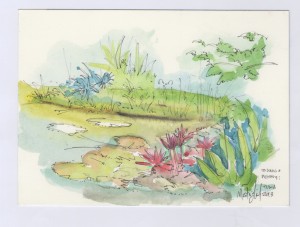
When he handed me the small picture he explained with a broad smile that the setting reminded him of Monet’s gardens. Wow, what a statement!
This put me a state of flashback of twenty years when my cousin Belinda invited me to celebrate her wedding anniversary with her because her husband Roger was abroad at the time. We got in the car and drove from the region of Versailles where she stays to Giverny, the home of Monet. The beauty that he captured in all the gardens was a joy to the eye.
So, can you imagine how moments in time can intertwine and bring forth so much exhilaration due to aspirations, dreams, and their manifestations? After all, that is the zest of life.
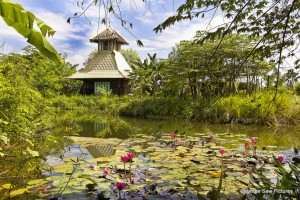

Photo Credits: John Vermeulen
It is that time of the year where we see less light, the temperatures are dropping and the sun is moving closer to its lowest glimpse of the horizon. On December 21, as with every year, the shortest day- the winter solstice- will pass by once more and then three days later, the sun will start crawling up the skies towards that long awaited spring time which will start three months later.
Even in the tropics it can get rather cool, and when the humidity is high, it can fool you in believing that it might be ten degrees Celsius whilst it is twenty-one degrees. And for us being at the foot of a mountain does amplify things even more due to the winds and cloud development. At the same time, this is where the magic begins if you want to grow unique food or in a different way, create amazing garden flavours.
Currently the coffee berries are ripening, their green color fading into a dark deep red that can even turn dark purple, this is when the sugars are the ultimate height for full aroma blends. So picking the bean at the right time can make that much of a change in the outcome of that soothing cup in the morning. But the roast is of equal importance – getting the coffee beans to heat up and transform those sugar cells into a delicious caramelized aroma and are released as the pot brews.
We recently got a scare when a tropical storm was developing on the east coast of the island line and I was holding my breath as the satellite images drew the images of the cyclone as it approached towards us, its international name was Hagupit for everybody out there, but it was called ‘Ruby’ in the Philippines. That does sometimes throw me off, people might be talking of a phenomena and I can not relate due to renaming of things, does that make life easier?
What was so very unique about this event of a potential mega-typhoon growing was that it was rising in conjunction with the moon, the three quarter was going to make full face in the landfall of the event. What this spells out, if you pay close attention to the weather, is that the coinciding motions start to create a pattern, the rains of that period will keep on flowing through for the next ten days to two weeks.
And as the tides flow in and out on a daily pace, there is a subtle change in the rise of the currents; that is due to moon drawing water.
How does this translate to the plants that grow all around us?
If we could choose the best time to sprout beans, the start of the new moon would draw the best results. This is due to the gravitational force of the Earth, the roots of the sprout are drawn down, and as the moon increases it’s force upward, so will the stem develop stronger. After the full moon, there is a balance of the upper and lower part of the plant, a strong energy flow is present and in the last quarter, the plant is in a state of rest.
We can see that everything is related to energy and water, and if we were to relate it to harvesting fruits, our best choice in time to get the ripest and fullest nectar out of nature would be on or around three days after full moon, all the moisture is drawn up and stored in the crown.
If you were to prune a tree, the best time would be at new moon, since the life force is stored in the lower root system and so the forces would not be lost too much in the removed branches.
When harvesting a seed like rice or lentils, the new moon would benefit us as the roots have all the water stored and hence, we do not have to dry the seeds too long as they are drier than during the full moon.
Do not mistake moisture with life essence, as the plant produces fruit for future reproduction and nature never holds back to giving itself the best it can to accomplish this goal.
The amazing lesson we can observe from nature is that it does not judge, it only wants to give it’s best.
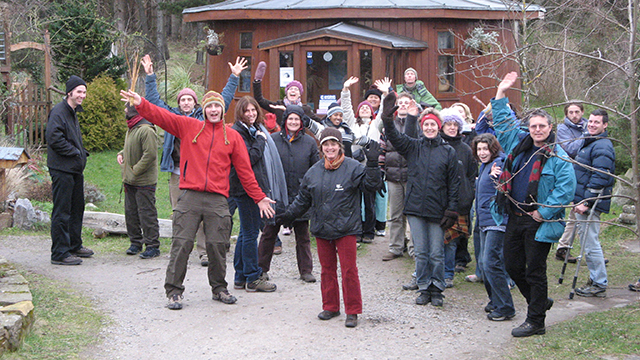
How often do we stand at a crossing point in our lives and we need an answer to help us in the right direction?
For some people it might be reading their horoscope, some try their luck with the I-Ching or consult with a wise fortuneteller.
But there are other journeys that people have travelled for hundreds of years, rituals that help the mind move past to the next level. One of these journeys is called a sweat lodge, a form of a sauna-like set up that can be found in old Native American Indian traditions or in the Scandinavian countries.
But there is more to it than meets the eye, after all, they are rituals and these rituals are lead by an elder, very often a shaman who knows how to prepare the space and keep it safe. When a journey is made, one is vulnerable whilst traveling through the elements as our forefathers and elders did with the wisdom and guidance of the stonepeople.
My journey started a few years ago while I was writing my Masters Thesis Industrial Design in Cape Town, South Africa and I wanted to do some research on sustainable development. A friend had just visited the Findhorn community in Scotland for a few months and she mentioned that they were offering in-depth courses on community –ecovillage- trainings; this was evidently also my first introduction to permaculture.
Fortunately, I was able to make my way there and part of the one-month course was filled with a design component. After having seen the neglected sweat lodge, I requested to reconstruct it and learn the rituals behind the journey. My wish was granted and so I set-off to research the meanings behind the motions, a spiritual journey to enrich me for a long time.
Together with two other participants, we set out and prepared the sacred space for a journey with all our classmates – we were twenty-three in total and had thirteen nationalities among us. The hut frame was made from willow twigs- these symbolize the flowing of water and how humanity is dependent on it, as it is part of creation. During the harvesting of the willow branches, a blessing of sacrifice was made to the tree for it to aid in the process of re-cleansing.
The dome shape hut had a diameter of about three meters and was about one and a half meter high in the center. The entrance of the hut was facing east and in the center of the floor there was a small pit that was connected with a narrow canal –the path of life- running eastward to the outside where it connected with a bigger pit. The dome represents the mother’s womb – the feminine energy- and the bigger pit is for the fire –masculine, and it symbolizes the seed- where the rocks were to be heated to a glow.
The willow frame was then covered with wool blankets to insulate the structure as the heat that would later be generated by the steam- the healing component-could stay in the space; after all it was mid-winter and the Scottish nights get very icy cold. Traditionally the lodge would have been covered in hides but the meaning still remains – it being the skin of the mother that protects us.
During the morning of the ritual, we were asked by our mentor to go out and search for a rock in nature with about the size of our head, as a way of preparation. Once we found our rock, we carried it while asking questions about events we wanted insight to in our lives or troubles concerning us, then we carefully placed the rock on the edge of the fire pit in preparation of the event.
Keeping in mind that this is a very sacred journey, it is a very voluntary experience, and so, several of our Eastern classmates did not feel comfortable to participate in the event but they were given an equal chance to partake. Some of them took a small piece of red cloth, placed some tabaco, salt and their prayer into it, closed it up with a string and hung it from the roof on the inside of the dome before the ritual started, so that these too were made part of the journey.
As the fire was lit in the fire pit, the shaman faced the east, thanking all the directions of life being present and how the fire was the symbol for vision and was awakened by the sounds of cymbals. Then we turned to the north with the sound of a drum and we could feel the presence of the warrior in us. The west holds the water and clicking stones reminded us of the gifts we have now. Finally we faced south and the rattles gave the vibrations of healing.
We had two keepers of the fire and they carefully placed the stones in it to bring them to a brilliant red before they were placed inside the hut. Slowly as they warmed, we became aware of the sky above us, the dark star-filled night, the Earth below us as it was turning moist as the dew set ,and the excitement within as this was part of a soul search. While we would be in the hut, the fire keepers guarded the lodge, since we were very vulnerable in our spiritual nakedness.
Our group was a mixed gender; ideally one would enter the lodge without clothes but a towel was more than welcome. Fortunately, we all felt comfortable with each other and as we crawled into the lodge from the bottom south east end of the path of life, our journey to the past begun in a tense silence. The circle was tightly packed as we found ourselves in utter darkness, and slowly the spaces started glowing as the shaman asked for the rocks to be rolled into the center via the path of life. Water was sprinkled onto the stones and the steam associated with cleansing soon filled up the cold space. A speaking stone was passed on and we were able to share our stories of the past, whether it was pain, confusion or words of beauty, everything seemed to be relevant and there was time to understand and live with others in a universal journey, life, all created in that womb!
After about forty-five minutes, we crawled out of the lodge at the top north east point and walked past the fire pit towards a patch of grass and we rinsed ourselves with water, what a cleansing enriching feeling it was! Lying on the grass, naked and looking upward towards the stars in the winter weather is a liberating and carefree feeling.
The next round was dedicated to the present. New stones were slowly brought into the pit; we reflected on where we currently are and how we feel. The darkness was filled by aspiration and doubt while people were sharing – and the speaking stone moved from one hand to the other – each persons’ time of sharing was respected.
I started to see shapes in the soft glow of the stones, spirits danced before my eyes and they brought calmness to my soul, a recognition of my existence. Slowly my hands blended the sweat from my face with the soil beneath me and I painted my body and face with snaking patterns of mud.
When this session finished, I found myself under the stars once more, wet with icy water and my heart beating twice its speed, this was when I knew that my life was too full – of adventure, exposure and contact with too much. This insight was pivotal because my personality is of a reclusive type.
As we entered the last round into another circle beyond the comfort zone, our shaman brought in the brightest hot stones, they hissed as the water teased them and the moisture released a freedom – the potential of being. This round was all about how one can apply or dedicate their life on whatever path they choose.
This was when people made their vows – spoken or unspoken. It was a point of rebirth, about letting the past be and seeing that what we would walk out into was our own chosen destiny.
This journey was the beginning of a new dream for me, a cleansing and a way for my soul to reconnect to the Earth – my mother and the carrier of All. The sweating was hygienic; all life was in it and this slowly ebbed away into the night of memories.
Respect for others had become a pact, treat others with respect and celebrate the elders, as they lead us in wisdom on a path of life, sometimes in pure silence.
Those who did not partake in the actual ritual chose to lovingly cook us a wonderful soup to warm our bellies after an etheric cleansing. We relished the broth in total silence, as we were asked to let the evenings experience stay with us and reflect on the big impact of this experience to our lives.
After my rendevous with the divine, the next steps challenged me to put words into my actions and required of me to reflect on the world with all it’s materialistic components – to really ask myself the question of what was still relevant to me.
And the answer came loud and clear: My goal was to acquire good books, save as much knowledge on as many topics related to growing and processing food, find a piece of fertile land, grow a diverse range of plants to benefit people, and research all the medical uses of what was growing wild. Facing this transformative realization, I told myself, “what an amazing journey this could turn into!”
Now, several years later, I can say with great joy in my heart that my blessings have been granted. The land that I nurture everyday surprises me with abundance, life, and the courage to do even more.
Wisdom lies in the doing and the willingness to grow from within.

Photo Credits: John Vermeulen

Photo Credits: John Vermeulen
Several years ago, we were challenged by a stream of ants! They would pass over the threshold of the door of our two kitchens, which were connected with a one step elevation. Very often it would happen that somebody would just stand in the doorway to chat and would get attacked by ants, after all, we were invading their space and were stepping on them. But they were in our house, so there had to be a solution to this challenge.
So how did we manage to resolve the issue, and at the same time retain the ants?
We got down on our knees, analyzed a potential alternative route for the ants to take, made a mental path with our finger along the bottom of the threshold as opposed to over, and then we asked them with intent, to ‘start using that way’ as soon as possible.
Low and behold, the next day, we could stand in the doorway, and the ants were busy with their daily activity, with a slight detour. The ants followed our request and it did not even seem to mind them!
Another useful partnership example is when ants clean up our leftover food. Whenever we need to have an empty bag of sugar, milk carton or flour sack cleaned, we do not rinse it, but instead, leave it out on a spot that we know is frequented by ants, and in wink of an eye the ants do all the work for us, ready to recycle!
Before we built our new house in Lipa, we studied the land and it’s surroundings to get a better insight as to what we were planning for the future. Permaculture is a great tool to analyze landscapes, contour lines, water flow and the biological life, uniting all components into a holistic picture.
The biggest challenge that we noticed right away was the amount of termites eating away at all the old wood and at the ants climbing on us and giving us enough acid zaps to dance to.
Permaculture sees solutions and not the problems. And if there are any good indicators of a fast turnover of biomass into fertilizer they are the termites, ants and fungi. After all, both the termites and ants collect appropriate lignin sources that they incubate in fungi grow-rooms underground to later be used for their new offspring as food.
At our forest that surrounds us, we find all kinds of mushrooms of which we have identified four types that we can eat. The one in the picture is the Pleurotus pulmonarius or the lung oyster mushroom, which has medical applications such as anti-inflammation and a cure for hay fever, besides being very tasty. They pop-out of the wood, which is shaded by ferns and trees to provide a feast, nature is just abundantly giving.
Our house was built on pillar stilts to make our lives a bit easier coping with the termites and we placed a water lock around each post to keep the ants at bay. What also helps to keep turmites away is to clean up around, removing all dead wood since these are termite attractors due to the high emission of CO2 –carbon dioxide- released during fungal decomposition.
Besides that, we planted a lot of turmeric around as old folk tales shared that it too could help. ‘No harm in that’, we thought – after all, turmeric is an amazing health source and a potential income from the dried root that is ground to a powder!
Once we take the time to deeply interact with where we are, we might be amazed what kinds of connections we can make with and in nature. After all it is in continuous motion, a vibration and a pulse. In this time and age of knowledge we need to awaken the wisdom of nature in our own nature and utilize it, work with it and create oneness.
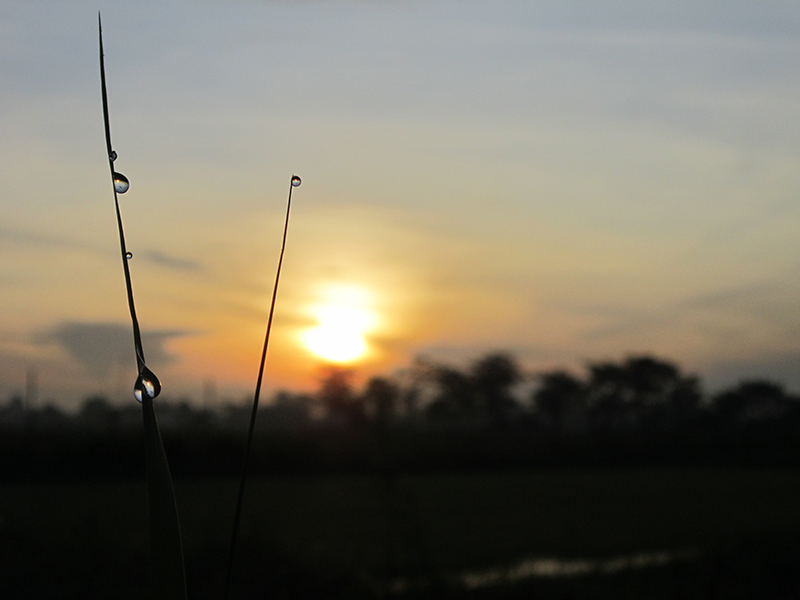
Photo Credits: Fernando
Nature is amazing, mesmerizing and giving. And so a new day begins, with rays of sunlight playing with dewdrops on the leaves- and as they change the tension of the water meniscus- rolling escalates into drops falling everywhere. There might not be rain for a while but the humidity in the air keeps things moist.
Hello, my name is John. I was born in South Africa, my parents are Dutch, and I have been very blessed to have traveled our beautiful planet- passing its oceans and many landmasses. In my journey, I have managed to see stunning patterns around me and thus, I have been influenced by the great masters of Gaia.
Currently, I live in the Philippines, on the main island Luzon, in the city Lipa based in the province of Batangas. Lipa is the third coolest city in the Philippines thus, its climate is great for coffee growing. It is also here where the Spaniards planted the first coffee seedlings.
Together with my wife Penelope (Penny), we run a 6,000 square meter coffee farm and education center to inspire people with the potential of growing abundance.
So what inspires me? Well, the main secret is Permaculture!
In a nutshell, it gives us a tool to see the connections of relationships, ratios of form and how they all function in harmony, as everything feeds into another, everything is vibration, thus energy. Nature does not know guilt, it only gives freely.
Imagine laying under a mango tree with its branches swaying in a spring breeze. This tree can reach up to fifteen meters in diameter and grow over thirty meters tall in a span of eighty years. Its fruits are filled with nectar from the Gods! Just peel the skin away from the flesh and the sap drips its ambrosial sweetness, leaving a sweet scent of pure decadence.
How does this abundance evolve its form? Well, the main secret is the power of the Sun, since it is stored and transformed by the plants into protein energy. Together with the Air- with its balanced mix of nitrogen, oxygen, carbon dioxide and other noble elements, Water- which is the carrier of life, and the Soil, which nurtures a place for all of Life to happen.
Wow! Just reflecting on that mouthful… I get excited! As a human, I can use this powerful realization to create an amazing place on this planet!
Many years ago, I was fortunate enough to wander through the gardens of the famous painter Claude Monet in France. It was a pleasant surprise to see that in his home, he had many prints of Japanese art works, whether they were about crafts, structures or daily activities, and it was evident that Japanese culture clearly inspired him.
In his garden, he had apple trees planted, but they were sculptured very similarly like bonsai. These trees were only waist high, but had two branches on opposite sides of each other that reached out for almost twenty meters, and were bearing lush fruit.
When we understand the language or pattern of a natural element or system, we can grow into a symbiosis with it and create abundance and beauty. Nature is generous and willing to give, always giving priceless treasures- let us just love it for what it is willing to share.



